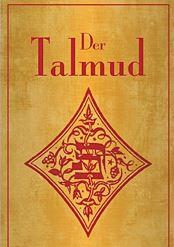Talmud

The Talmud is one of the central texts of Judaism, second in importance only to the Hebrew Bible (Tanakh). It's not a single book, but a massive compilation of Jewish law, ethics, philosophy, customs, and history — kind of like a combination of legal code, spiritual guidebook, and intellectual conversation spanning centuries.
📜 What is the Talmud?
At its core, the Talmud is made up of two main parts:
1. Mishnah (c. 200 CE)
-
The first written version of the Oral Torah
-
A collection of legal rulings and teachings from earlier rabbis (called Tannaim)
-
Organized into six orders (agriculture, festivals, women/family, civil/criminal law, sacred things, purity laws)
2. Gemara (c. 500 CE)
-
A commentary and discussion on the Mishnah by later rabbis (called Amoraim)
-
Includes debates, stories, case law, logic, philosophy, humor, and ethics
-
Expands and explains the Mishnah in rich detail
📚 Two Versions of the Talmud
| Version | Place/Time | Notes |
|---|---|---|
| Jerusalem Talmud | 4th century, Land of Israel | Earlier, shorter, less studied |
| Babylonian Talmud | 5th–6th century, Babylon (modern Iraq) | Longer, more detailed, most widely used in Jewish tradition |
When people say “the Talmud,” they almost always mean the Babylonian Talmud.
🧠 What’s Inside?
-
Halakha: Jewish law – how to live daily life (from prayer to contracts to food)
-
Aggadah: Stories, parables, ethics, theology, folklore, mystical hints
-
Debate style: Rabbis argue different points of view – often with no final answer
-
Layered text: You read Mishnah + Gemara + centuries of commentaries
Imagine a long, deep, passionate conversation among hundreds of brilliant minds across time.
✡️ Why Is It Important?
-
It’s the foundation of rabbinic Judaism — the Judaism practiced by most Jews today.
-
It’s shaped Jewish law (Halakha), education, community life, and culture for 1,500+ years.
-
Studying it is considered a spiritual act, not just intellectual.
👓 How Is It Studied?
-
Often in pairs (chavruta) — to sharpen understanding through questioning
-
Requires knowledge of Hebrew and Aramaic
-
It’s not easy reading — complex logic, references, and codes
✡️ 1. Jewish Law (Halakha) – Living the Commandments
The Talmud is the primary source of Halakha, or Jewish religious law. It doesn't just repeat the Torah's commandments — it interprets, expands, and applies them to daily life.
Everyday Practices Influenced by the Talmud:
| Practice | Talmudic Foundation |
|---|---|
| Keeping kosher (kashrut) | Rules for food prep, separation of milk and meat, animal slaughter (e.g., Chullin) |
| Sabbath observance | Detailed laws about what work is forbidden and how to honor Shabbat (e.g., Shabbat tractate) |
| Prayer structure | Times, content, and format of daily prayers (e.g., Berakhot) |
| Family purity laws | Rules about relationships, menstruation, and immersion (e.g., Niddah) |
| Holidays | Rituals for Passover, Sukkot, Purim, etc., and how to perform them |
The Talmud doesn’t just say what to do — it also records why, and different rabbinic opinions on how.
🧠 2. Ethics and Daily Conduct
Beyond rituals, the Talmud teaches:
-
How to treat others: honesty in business, charity, kindness to animals, hospitality
-
Dispute resolution: not just legal courts, but how to settle community arguments with fairness
-
Character development: humility, patience, respect for parents, gratitude
These teachings shape how observant Jews think, speak, and relate — not just what they do.
🧑🏫 3. The Value of Study Itself
-
Talmud study is a mitzvah (commandment) in its own right.
-
In Orthodox communities, yeshivas (religious schools) dedicate years to Talmudic learning.
-
Even secular Jews sometimes engage with the Talmud intellectually or culturally.
It's not just law — it's seen as divine dialogue, a sacred practice of seeking truth through questioning.
🕍 4. Religious Leadership & Authority
-
Rabbis are expected to know Talmud.
-
Halakhic rulings (Jewish legal decisions) still reference the Talmud as their core source.
-
Every modern Jewish legal code — like the Shulchan Aruch — is based on Talmudic rulings.
🌍 5. Modern Examples of Talmud's Influence
-
In Jewish weddings: the ketubah (marriage contract) format comes from the Talmud.
-
In mourning: customs like sitting shiva and saying Kaddish trace back to Talmudic sources.
-
In business: ethical principles like not overcharging or false advertising come from Talmudic law.
🌟 1. The Talmud as a Spiritual Practice
Talmud study is not just academic — it’s a form of devotion.
-
Studying it is seen as a holy act, a way to connect with God’s will.
-
Every argument, nuance, and question is treated with sacred weight.
-
The tradition of chavruta (learning in pairs) sharpens the mind and heart — it’s a spiritual relationship built on inquiry.
✨ In essence, wrestling with the Talmud is wrestling with God — much like Jacob did.
🧩 2. Spiritual Meaning in the Details
Even the tiniest details in the Talmud can be spiritually rich:
-
Why does the Sabbath begin at sunset? → Connects us to the cosmic rhythm of creation.
-
Why three daily prayers? → Aligns us with different aspects of the soul and divine presence.
-
Why so many rules about speech, money, food? → Because every act in daily life can be infused with holiness.
The Talmud turns the ordinary into a gateway to the divine.
🕍 3. Shaping Identity and Belonging
For many Jews, studying the Talmud — even a little — creates a deep sense of connection:
-
To their ancestors (this text was studied for 1,500+ years)
-
To community (shared rituals, ethics, rhythms of life)
-
To a covenantal story — being part of a people constantly in dialogue with God
It keeps Judaism dynamic, debate-driven, and living — not frozen in the past.
🧠 4. Talmud and the Inner Life
While the Talmud is not a mystical text like the Kabbalah, it still touches on the inner world:
-
Ethical reflections: anger, jealousy, humility, patience
-
Personal growth: repairing character flaws (tikkun hamiddot)
-
Faith through uncertainty: many passages explore doubt, silence, paradox, and suffering — without always giving easy answers
These teachings can guide modern spiritual seekers, regardless of belief level.
🕯️ 5. In Progressive & Secular Jewish Life
Even outside of traditional observance, the Talmud still resonates:
-
Reform and Conservative Jews may use its ethics to inform social justice and community values
-
Secular Jews may find inspiration in the intellectual rigor and moral questioning
-
Some spiritual seekers find its non-linear, poetic structure surprisingly resonant with contemporary mysticism
🔁 Talmudic Spirituality Today – In a Nutshell
-
It’s about connection — to God, community, tradition, and yourself.
-
It’s about transformation — through learning, reflection, and sacred living.
-
And it’s about dialogue — where even uncertainty becomes a spiritual path.

